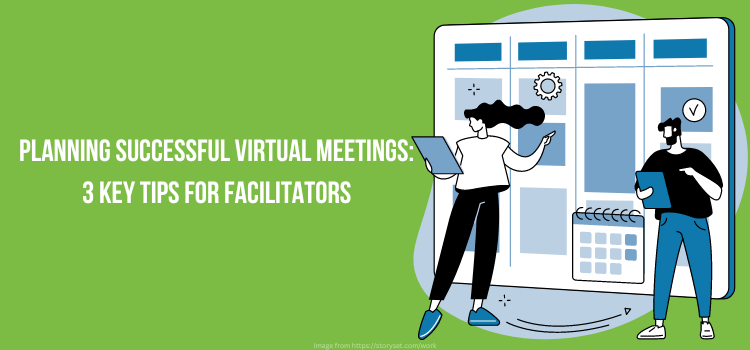Meetings are now an essential part of our work and personal lives. However, meetings of any kind, especially virtual meetings, can be frustrating and unproductive if not facilitated properly. In our previous posts, we discuss why virtual meetings suck and introduce the SCARF Model, which highlights five domains that affect social engagement or, in our case, participation in meetings. These domains are Status, Certainty, Autonomy, Relatedness, and Fairness. Any meeting space presents many challenges that threaten how we feel regarding each of the SCARF domains and, when we feel threatened, we’re less likely to engage and participate. So, how can we prepare our meetings in a way that anticipates and reduces these challenges? Keep reading for three key tips for planning successful meetings.
Step 1: Set Outcomes
When planning a meeting, participatory facilitators must begin by establishing clear, participant-centered outcomes for the meeting. Facilitators need to both know and communicate what it is that the meeting will accomplish. This will not only help to better identify who does and does not need to attend, but also ensures that all participants understand the purpose of the meeting and can determine if it’s a good use of their time. This step also helps facilitators avoid the dreaded “This could have been an email” feedback and saves participants from the frustration of an unnecessary meeting, because we all probably have too many as is.
A good outcome starts with “participants will” and includes a verb with a detailed outcome for the meeting time. The following is an example of an actionable, detailed outcome:
- Participants can define a microaggression and can explain how to address a microaggression during a conversation with different types of partners/stakeholders (i.e., colleagues, community members, partners).
SCARF Domain: Certainty, Autonomy
Step 2: Design a Detailed Agenda
Designing a detailed agenda with time blocks for tasks and discussions is an important aspect of participatory facilitation. This step allows all participants to have a clear understanding of what will be discussed and when, reducing uncertainty and anxiety that participants may feel leading up to the meeting. It is also important for facilitators to practice using any collaborative tools (e.g. Miro, Mural, or FigJam) that may be used during the meeting and include links to the tools in the appropriate section of the agenda for participants to easily access. Finally, it is a good idea to enlist a co-facilitator to take notes and help with potential tech problems. This allows the facilitator to focus on moving the group through the agenda, following time blocks, and engaging all participants during the meeting.
SCARF Domain: Certainty
Step 3: Share the Agenda and Helpful Info Before the Meeting
Once the agenda has been created, facilitators need to determine any additional information (e.g., previous meeting notes, reports, or data) that would be helpful for participants to review before the meeting, with links to the material included in the appropriate agenda section. Providing participants with the agenda and helpful information ahead of time allows participants to know what to expect out of the meeting. Participants will also be more likely to come prepared and ready to engage in meaningful discussions during the meeting. This also helps to level the playing field by ensuring each participant has the information they need to participate no matter if they’re new to the group or a long-time member.
SCARF Domain: Certainty, Autonomy, Fairness
By taking these steps and keeping the SCARF Model in mind, participatory facilitators can create meetings that are more productive, engaging, and less frustrating for all involved. Now that you know how to plan a successful meeting, it’s time to focus on strategies to employ during the meeting to make sure it is engaging and productive. We’ll cover that in our next blog.
Below is an agenda and note-taking template:
- Google Doc version
- PDF version
- Word version
Are you interested in learning more about how you can develop your facilitation skills? Join us in the New School of Participatory Change in our Participatory Facilitation course. In this online cohort experience, you’ll work with us to develop your own practical approach to facilitating participatory conversations, whether in front of a computer or in front of a room.
Click here to learn more about the New School and how we can help you become a better participatory facilitator and changemaker.

